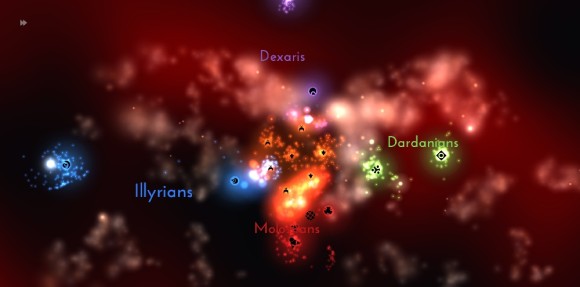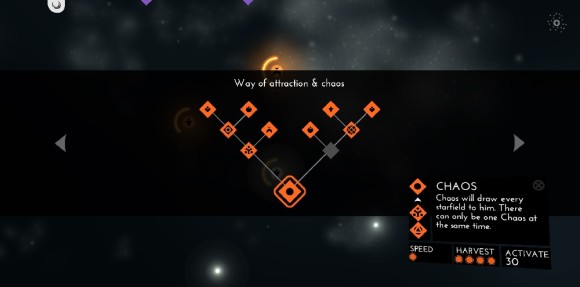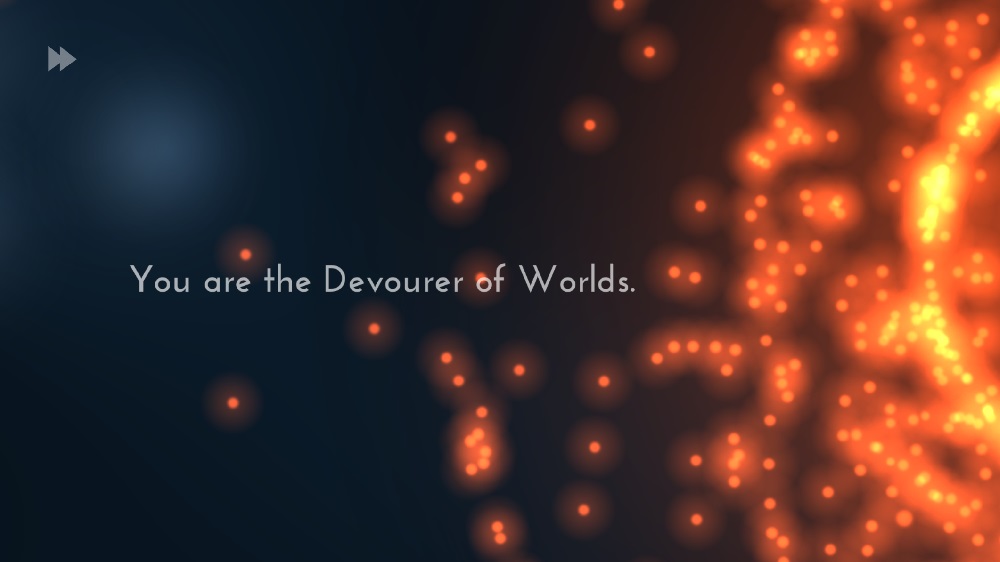
Considering that the Greek gods, as represented in classic Homerian epics, are usually little more than a bunch of petty, self-absorbed, squabbling superhumans, we’ve gotten a lot of mileage out of them. Sometimes they’re represented with rather more inherent nobility and stature than they deserve. Not so in Devouring Stars, a science fiction real-time strategy game that draws inspiration from Eufloria, Boid and their ilk, alongside science fiction novels like Hyperion and Ilium (both by US author Dan Simmons) which plumb literary and mythic history.
The game is currently available on Steam Early Access; it just hit its v0.3 release which added multiplayer. It’s reportedly almost feature complete; most of the remaining work concerns balance tweaks and bug fixing.
I’m a little on the fence about Devouring Stars as it stands. And that is a sentence I almost hate myself for typing. I like Devouring Stars a lot, both for what it is and for the design philosophy and SF concept behind it. But I also have issues with it, and those clash with some of the reasons I like it.
I’ll try and explain why, but first let’s run through the basics. In Devouring Stars you’re controlling a tribe of godlike entities. I like to think of them as hyper-advanced humans who have ascended into a pure energy species and yet retain some very human habits: squabbling, consuming and warring with other tribes who look very similar but are nonetheless The Enemy.
Each of these entities harvests stars from the fields and nebulae around it, wrenching them from their place in the firmament of space. When these godlike beings clash they slam stars against one another, unleashing colossal energies until a victor emerges or a combatant flees. It’s a wonderfully grand premise and one of the few I’m happy to dub ‘epic’.
In practice you’re nudging symbols around a map, watching as they harvest dots from clouds of nebulae, and occasionally pausing to check the pictorial representation of their ‘strength’ in number of stars. I’m happy to run with the grand vision, though. The game’s superb soundtrack helps; a collection of crashing piano and synth compositions that complement the high concept.
Four basic units can be variously combined to form new units with special abilities; there are three trees of combinations to explore, and each special ability opens up new tactical possibilities. Discovering what these are is one of the game’s early pleasures, and not all will be accessible until you’ve won a few ‘runs’ of levels and unlocked more starting units.

Among said special abilities are basics like increased harvesting speeds, special combat abilities and increased speed, alongside cooler tricks like short-range warping, capturing enemy units and turning them to your own side, and even a self-destructing unit that indiscriminately destroys everything around it as it goes.
Levels each involve a specific challenge; usually capturing a portal is key, but sometimes this will be defended by a particularly dangerous enemy ‘general’, or perhaps the portal appears in the centre of the level and you and your opponents are all zoning in on it. The most difficult level type I’ve encountered is the siege wherein one entrenched enemy tribe starts with a cluster of portals and units plus a good number of pre-harvested stars, whilst you and another opponent are both trying to dislodge them and capture the portals. Did I mention that enemy-owned portals constantly spawn new enemy units, whereas you just use them to warp your surviving units out? I have yet to work out a way of dealing with sieges levels effectively. I largely just avoid them.
Although compared to earlier in the year Devouring Stars now does a better job of explaining its core concepts and controls, it’s still easy to get muddled about which units combine to make which. Each is indicated with a certain symbol but whilst you’ll come to recognise these in time, remembering which combines with which is less natural. Fortunately selecting a unit does now indicate which other units in play it can combine with and what the result is; failing that, or to verify a sequence of combinations you want to make, you can pause to refer to the trees at any time.
This is part of why I’m a little ambivalent about Devouring Stars as it stands. The self-confidence behind its design is clear, and in these post-Dark Souls years I find it pleasing that it expects players to invest effort and thought into understanding it, rather than simply revealing all from the outset. However, this obtuseness can also work against it. The aforementioned experimentation in unit combination is dangerous to indulge in whilst still battling through a level, meaning dabbling with it after defeating all enemies but before moving through a portal is your best bet. This, however, clashes with the idea that there are routes to victory other than defeating all enemies.
The game can also be very challenging, which is a strength – once you learn the ropes. When the enemy starts with a natural advantage it will often push you aggressively, and it’s only after several hours of play that I understand better how to respond to that. Earlier on I found myself losing – a lot. Because each ‘run’ of levels involves carrying over units (although you start fresh between runs), losing even one unit can be a potential killer. There’s no restarting individual levels if you mess up, and stars collected by each unit are reset between levels, so you cannot build up strength for your survivors before progressing as an alternative tactic.
I’ve generally found the most success is to be had by aggressively pushing as many of your units as possible into the largest, densest nebulae and squatting there while you harvest. It helps to combine units into a combat-effective type and a fast harvester, with the latter feeding its stars to the former while the former fends off enemy attempts to intrude on these fertile grounds. Once you’re a little more established, killing off enemies who are left exposed becomes possible, and once their numbers are reduced it’s comparatively easy to box them in around a portal while you build your strength for a killing blow.
I’m still not sure how to deal with certain challenges – see the aforementioned siege levels – though I’m happy about that as it suggests the game has plenty of exploratory, learning play in it, rather than just devolving into a rote experience of dealing with known problems. I also like that Devouring Stars throws many level types at players almost from the get-go; it’s an uncompromising design decision. I do, however, wonder whether this difficulty will be interpreted as unfair by new players already put on the back foot by the game’s minimal efforts to teach play beyond the absolute basics.
Don’t get me wrong. I’ve been critical on a lot of details, but when looking at Devouring Stars writ large across the cosmos I like it. It’s got enough unique ideas to stand out among its peers, and in presentation and concept there’s little else like it. I enjoy its mix of abstract RTS, adaptive unit combination and re-combination, high-concept baroque space opera premise and audio splendour. But at present it’s a game I’ve bounced off a few times, and it’s only through bloody-minded persistence that I’ve begun to learn some of its intricacies.
[ Nb. I’ve not tried out the multiplayer mode yet – online multiplayer is a bit sparse at present, and I’m waiting on a suitable friend visiting to try out the local multiplayer. I can imagine it being pretty good if you get together two people with a decent amount of familiarity with the game’s concepts and unit trees, but not where experience is unequal. ]
